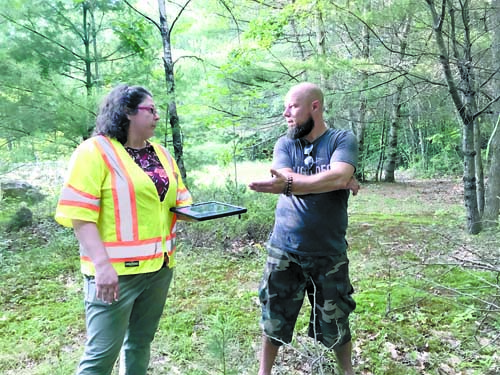Solar energy group asked to resubmit plan

By Dawn De Busk
Staff Writer
NAPLES — The Naples Planning Board drew the line in the sand.
More accurately, the line was drawn on the water.
The Solar Energy Ordinance prohibits any solar equipment from being seen from any body of water. Therefore, even a glimpse of a solar-energy apparatus from anywhere on any body of water will ensure that any solar-energy site plan will be turned down by the planning board.
On Tuesday, Sept. 7, after a site walk on the property where the proposed solar farm would be located, the planning board sent the company BWC Brandy Pond, LLC back to the drawing board. The board asked the applicant to create another plan that avoided having solar equipment on the high spots on the parcel.
The private property is accessible off Route 35. The site plan calls for slightly less than 20 acres to be used. At the highest points on the parcel, the solar arrays would be visible from Long Lake. That is according to projections made by the engineering firm, GZA GeoEnvironmental, Inc. The solar array trackers would be about 12 feet tall.
The property is next to Madison Heights Subdivision. Some of those neighbors attended the planning board meeting. They expressed concerns about having a solar farm in their backyards, especially since the site plan put the equipment within 100 feet of some homes, and also in spaces where there is very little vegetation or trees to buffer the view.
As soon as the agenda item came up, planning board member John Thompson recalled that it was discussed at a previous meeting that the ordinance prohibited solar projects in which equipment could be seen from any major body of water in the town.
“People don’t want solar arrays running up the mountainside because it ruins the view,” Larry Anton said.
When the Naples Ordinance Review Committee (ORC) crafted the amendments to the Solar energy Ordinance, it was decided that in keeping with protecting the town’s rural character, the solar equipment would never be visible from lakes or ponds, he said
“Send it back to the developer. It cannot be visible from any navigable waterway,” Anton said.
Later in the discussion, Anton said that because the amendments were approved at town meeting, the Naples citizens had decided “in order to grant solar projects in the rural district, it cannot be seen from the lake.”
Also, he stressed that the planning board did not have the leeway to grant waivers on this point.
“We didn’t say in the ordinance that the planning board can decide the visibility can be so much. It’s flat-out no visibility. There cannot be a waiver on this,” Anton said.
Ultimately, the board voted unanimously, 6-0, to send the site plan back to the applicant. After the vote, the board heard comments from abutters as well as applicant and land-owner.
Naples Planner Ben Smith clarified that status of the solar-energy project.
“The project has not been approved. The project has not been denied. It is the next step. It puts the ball in the developer’s court,” Smith said.
Timing is what caused the applicant to present a plan that conflicted with the town’s ordinance. Simultaneously, the ORC was honing the amendment to the ordinance while companies were lining up the details of proposed solar energy projects. As it turned out, the amendments were approved at town meeting before the applicant appeared before the planning board.
“We started the project prior to the development of the ordinance. We didn’t intentionally look at ordinanceand try to break it,” Mountain said
During the presentation, she mentioned the likelihood that the solar arrays would be seen from the lake.
“Because this array is being proposed on a hillside, portions of this array will be visible from Long Lake. We’ve got a couple photos that we simulated what the array would look like from these sites. About 1.2 miles away from the array, the top part of the array would be visible. As we move to the right, less and less of the array becomes visible. The last trajectory is 6 miles from the array,” Mountain said.
The neighbors commented.
George Leeman is on the board of the Madison Heights SubdivisionAssociation
“We are all part of a family, and it effects us all. We are very interested in anything that effects the water or the neighborhood,” Leeman said.
Stewart Purinton was at both the meeting and the site walk.
“The clear cutting starts closer than the array would be. I don’t want bull dozers right in my backyard,” Purinton said. “I am not against solar. I bought the house for the woods and now the woods are going to go away.”
Mike Soucie lives on 22 Franklin Dr. When he purchased his home, the land next to it was protected in tree growth, he said.
“It puts the solar array 20 feet from our backyard. I bought the property for the woods and the solitude,” he said. “That whole area behind our house. That is wintering deer herd area. There were deer in our yard today. We have dozens of owls.”
“I don’t know about you guys. It (solar arrays) is not something I want to look out my window and see. I want to see the wilderness,” he said. “Find a different site.”


